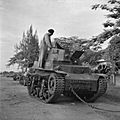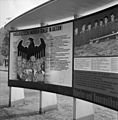Aftermath of World War II facts for kids
The countries that were involved in World War II went through changes after the war. Much of Europe was divided and left in ruins. The Marshall Plan was instituted to help rebuild Western Europe, while the Soviet Union controlled much of Central and Eastern Europe. Germany was divided, Japan and Korea were occupied by the United States and the Soviet Union, and the United Nations was formed.
Contents
The division of Europe
After the war, much of Europe was left in ruins. Millions of people were homeless, and the economy had collapsed. Europe was divided into two main sections. The Western Bloc, which consisted of Western Europe and Japan, was led and helped by the United States. The Eastern Bloc, which consisted of Central and Eastern Europe, was led by the Soviet Union and eventually fell behind the "Iron Curtain."
In 1947, the United States Secretary of State George Marshall began the "European Recovery Program," better known as the Marshall Plan. Between 1948 and 1952, the United States gave 13 billion dollars for the rebuilding of Western Europe.
The Soviet Union controlled much of Central and Eastern Europe along with the Balkans. The Soviets helped Communist regimes to come to power in all of the countries except Austria. They also added Estonia, Latvia, and Lithuania to their control.
Occupation of Germany and Austria
The Yalta and Potsdam conferences met to decide what to do with Germany. They decided that Germany was to be divided into four zones of occupation. Three of the sections, controlled by the American, British, and French, joined forces in 1949 to form the Federal Republic of Germany. The fourth zone, controlled by the Soviets, became the German Democratic Republic. Austria was separated from Germany and divided into four sections. In 1955, the four sections reunited to become the Republic of Austria.
Occupation of Japan and Korea
Japan was occupied by the U.S., aided by Commonwealth (British) troops until the peace treaty took effect in 1952. The Americans focused on three things during this time: demilitarizing the nation, destroying the Japanese weapons industry, and putting a democratic government in place that had a new constitution. The islands of Sakhalin were occupied by the Soviet Union and became part of it.
Korea was divided into two parts between the Soviet Union and the U.S., which created two separate governments in 1948. The northern part of Korea declared itself a nation and called itself the Democratic People's Republic of Korea. The southern part of Korea was supported by the U.S. and became an anti-communist country, called the Republic of Korea. The two governments fought each other in the Korean War from 1950-to 1953. They are still divided today.
China
The time of World War II was an important time of change in China's history. Before the war against Japan, China had suffered under the rule of different imperialist (royal) powers and was not powerful. Its president, Chiang Kai-shek, was able to build the country. The Republic of China became a founding member of the United Nations and a permanent member of the Security Council. In 1949, however, the Chinese communists won the civil war with the Kuomintang (the main political party) and began the People's Republic of China on the mainland. The Kuomintang retreated to Taiwan, where Chiang Kai-shek ruled until his death.
Border changes
Millions of people found themselves in hostile territory after the war. The victorious nations drew new borders to the countries, forcing people from their homelands. It is estimated that between one and two million people died because of being forced out of their homes.
Reparations
Reparation is paying or helping someone that you have wronged. Germany was ordered to pay reparations to the United Kingdom, France, and the Soviet Union. The United States took German patents and German-owned property in the United States. Italy, Romania, Hungary, Bulgaria, and Finland were also forced to pay reparations but were allowed to take back their responsibilities as countries and qualify for membership in the United Nations.
United Nations
The United Nations was created in 1945. Its purpose is to keep world peace and to improve living conditions for people all over the world. At its creation, 51 countries joined as member states. The United Nations now has 193 member states.
Two superpowers
The United States and the Union of Soviet Socialist Republics (USSR) were now the two most powerful nations in the world. Though they had both been part of the Allies during the war, they became competitors after the war. The United States had used two atomic bombs in 1945 and the USSR developed its own weapon in 1949. This led to the infamous "arms race," in which both countries tried to outdo the other in weapons and technology. The Cold War was one of the results of this power struggle. Part of the reason that the Cold War never became a "hot" war was because the Soviet Union and the United States each had powerful weapons, and they knew that if they used them against their enemy, they would be destroyed as well.
Quick facts about the aftermath of World War II
- Europe was divided into two main sections: The Western Bloc was made up of Western Europe and Japan. It was helped by the United States. The Eastern Bloc was made up of Central and Eastern Europe and the Balkans. The Soviets helped communists come to power in many of the countries in this area.
- Germany was divided into Eastern (German Democratic Republic) and Western Germany (Federal Republic of Germany).
- Japan was divided into two sections, with the U.S. controlling part and the Soviet Union controlling Sakhalin islands.
- Korea was divided into two sections: North and South Korea.
- Millions of people had to leave their homes because the borders of many countries were changed after the war.
- Several countries were ordered to pay reparations (compensation) to countries that had been damaged during the war.
- The United Nations was formed in 1945.
- The world saw two new superpowers - USA and USSR - rise to power and compete for dominance in weapons and technology.
Images for kids
-
The Trust Territory of the Pacific Islands in Micronesia administered by the United States from 1947 to 1986
-
Expulsion of Germans from the Sudetenland
-
The "Big Three" at the Yalta Conference: Winston Churchill, Franklin D. Roosevelt and Joseph Stalin. Diplomatic relations between their three countries changed radically in the aftermath of World War II.
-
Generalissimo Chiang Kai-shek, leader of the Chinese nationalist Kuomintang
-
Evolution of the border between the two Koreas, from the Yalta Soviet-American 38th parallel division to the stalemate of 1953 that was officially ended in 2018 by North Korean Kim Jong-Un and South Korean Moon Jae-In
-
Captured French soldiers from Điện Biên Phủ, escorted by Vietnamese troops, 1954
-
A soldier of an Indian armoured regiment examines a light tank used by Indonesian nationalists and captured by British forces during the fighting in Surabaya.
-
V-2 rocket launching at Peenemünde, on the Baltic German coast (1943).
-
Japanese soldier Hiroo Onoda offering his military sword to Philippine President Ferdinand Marcos on the day of his surrender, 11 March 1974
See also
 In Spanish: Posguerra de la Segunda Guerra Mundial para niños
In Spanish: Posguerra de la Segunda Guerra Mundial para niños
















